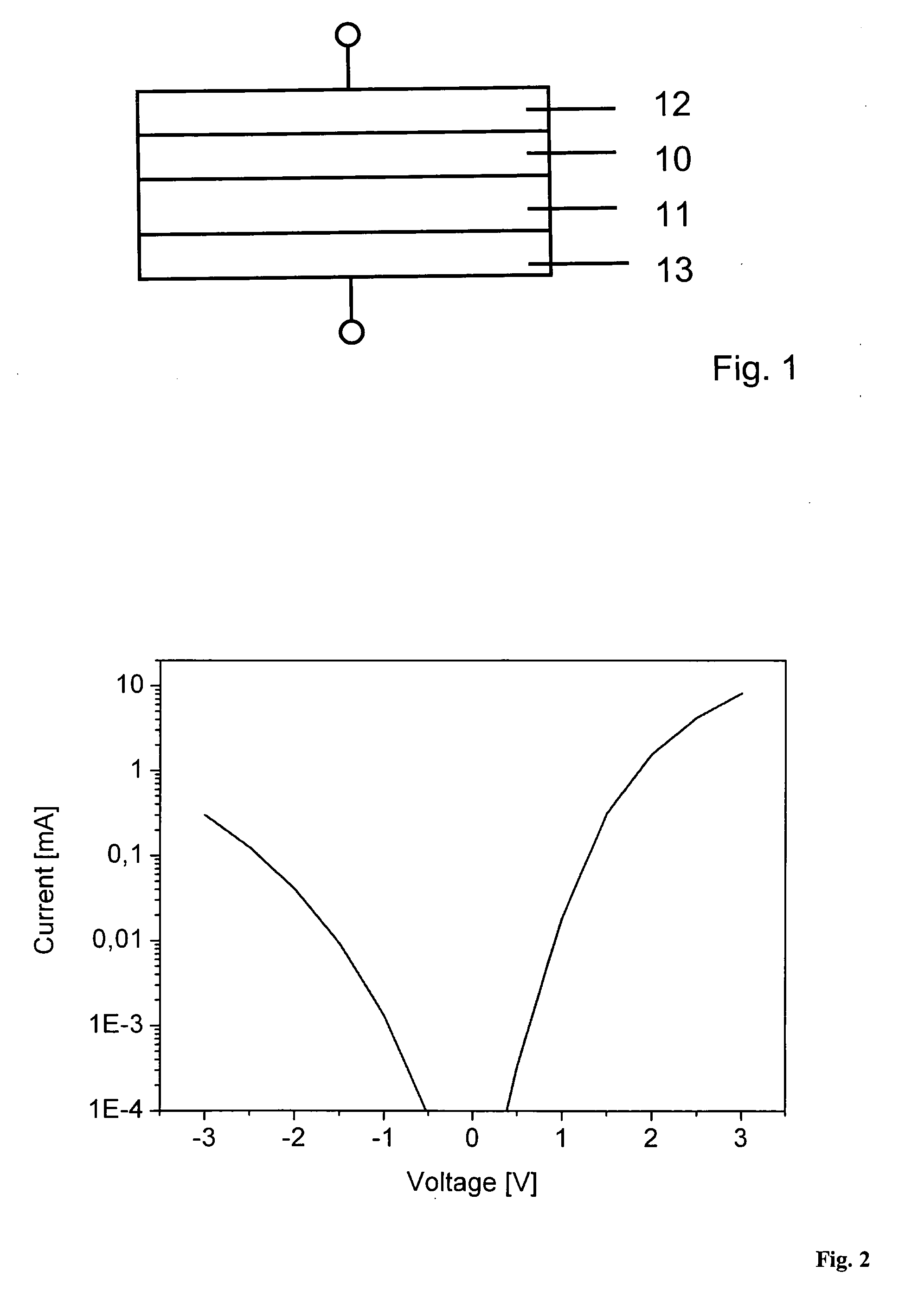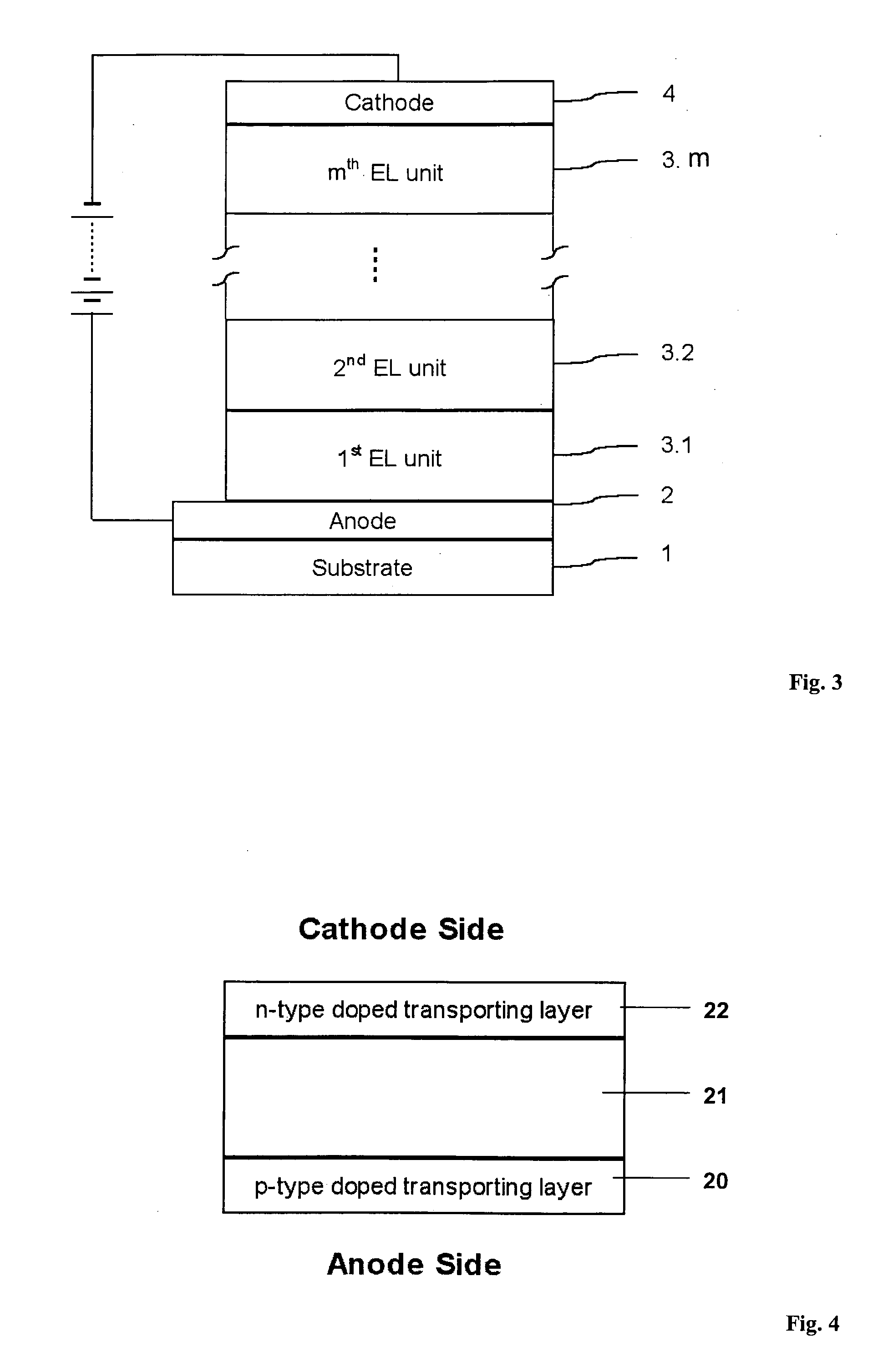Electronic device with a layer structure of organic layers
- Summary
- Abstract
- Description
- Claims
- Application Information
AI Technical Summary
Benefits of technology
Problems solved by technology
Method used
Image
Examples
example 1
Conventional
[0098]According to Example 1a structure for a conventional light emitting device is provided as follows:[0099]1.1 50 nm 2,2′,7,7′-Tetrakis-(N,N-di-methylphenylamino)-9,9′-spirobifluorene doped with 2-(6-Dicyanomethylene-1,3,4,5,7,8-hexafluoro-6H-naphtalen-2-ylidene)-malononitrile (p-type doped hole-transport layer);[0100]1.2 10 nm NPB (interlayer);[0101]1.3 20 nm Spiro-DPVBI;[0102]1.4 10 nm Bphen;[0103]1.5 45 nm Bphen doped with Cs (n-type doped electron-transport layer);[0104]1.6 50 nm 2,2′,7,7′-Tetrakis-(N,N-di-methylphenylamino)-9,9′-spirobifluorene doped with 2-(6-Dicyanomethylene-1,3,4,5,7,8-hexafluoro-6H-naphtalen-2-ylidene)-malononitrile (p-type doped hole-transport layer);[0105]1.7 10 nm NPB (interlayer);[0106]1.8 20 nm Spiro-DPVBI;[0107]1.9 10 nm Bphen;[0108]1.10 20 nm Bphen doped with Cs (n-type doped electron-transport layer);[0109]1.11 100 nm Aluminum (reflective cathode).
[0110]This is a blue stacked PIN-OLED where layers 1.1 to 1.5 constitute a first PIN-OLE...
example 2
[0113]According to Example 2a structure for a light emitting device is provided as follows:[0114]2.1 50 nm 2,2′,7,7′-Tetrakis-(N,N-di-methylphenylamino)-9,9′-spirobifluorene doped with 4 mole % 2-(6-Dicyanomethylene-1,3,4,5,7,8-hexafluoro-6H-naphtalen-2-ylidene)-malononitrile as p-type doped hole-transport layer;[0115]2.2 10 nm NPB as interlayer,[0116]2.3 20 nm Spiro-DPVBI;[0117]2.4 10 nm 2,4,7,9-Tetraphenyl-1,10-phenanthroline;[0118]2.5 45 nm 2,4,7,9-Tetraphenyl-1,10-phenanthroline doped with 5 mole % Tetrakis(1,3,4,6,7,8-hexahydro-2H-pyrimido[1,2-a]pyrimidinato)ditungsten (II) as n-type doped electron-transport layer;[0119]2.6 50 nm 2,2′,7,7′-Tetrakis-(N,N-di-methylphenylamino)-9,9′-spirobifluorene doped with 4 mole % 2-(6-Dicyanomethylene-1,3,4,5,7,8-hexafluoro-6H-naphtalen-2-ylidene)-malononitrile as p-type doped hole-transport layer;[0120]2.7 10 nm NPB as interlayer,[0121]2.8 20 nm Spiro-DPVBI;[0122]2.9 10 nm 2,4,7,9-Tetraphenyl-1,10-phenanthroline;[0123]2.10 20 nm 2,4,7,9-Tetr...
example 3
[0127]According to Example 3a structure for a light emitting device is provided as follows:[0128]3.1 75 nm 2,2′,7,7′-Tetrakis-(N,N-di-methylphenylamino)-9,9′-spirobifluorene doped with 4 mole % 2-(6-Dicyanomethylene-1,3,4,5,7,8-hexafluoro-6H-naphtalen-2-ylidene)-malononitrile (p-type doped hole-transport layer);[0129]3.2 10 nm NPB (interlayer);[0130]3.3 20 nm NPB doped with Iridium (III) bis(2-methyldibenzo[f,h]quinoxaline) (acetylacetonate);[0131]3.4 10 nm 2,4,7,9-Tetraphenyl-1,10-phenanthroline;[0132]3.5 60 nm 2,4,7,9-Tetraphenyl-1,10-phenanthroline doped with 2 mole % Tetrakis(1,3,4,6,7,8-hexahydro-2H-pyrimido[1,2-a]pyrimidinato)ditungsten (II) (n-type doped electron-transport layer);[0133]3.6 45 nm 2,2′,7,7′-Tetrakis-(N,N-di-methylphenylamino)-9,9′-spirobifluorene doped with 4 mole % 2-(6-Dicyanomethylene-1,3,4,5,7,8-hexafluoro-6H-naphtalen-2-ylidene)-malononitrile (p-type doped hole-transport layer);[0134]3.7 10 nm NPB (interlayer);[0135]3.8 20 nm NPB doped with Iridium (III) b...
PUM
 Login to View More
Login to View More Abstract
Description
Claims
Application Information
 Login to View More
Login to View More - R&D
- Intellectual Property
- Life Sciences
- Materials
- Tech Scout
- Unparalleled Data Quality
- Higher Quality Content
- 60% Fewer Hallucinations
Browse by: Latest US Patents, China's latest patents, Technical Efficacy Thesaurus, Application Domain, Technology Topic, Popular Technical Reports.
© 2025 PatSnap. All rights reserved.Legal|Privacy policy|Modern Slavery Act Transparency Statement|Sitemap|About US| Contact US: help@patsnap.com



